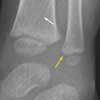Photoclinic: Growth Plate Fracture
A 16-month-old toddler was brought to the emergency department after he and the sibling who was carrying him fell down a flight of stairs. The child had not been able to bear weight on his left ankle since the fall and resisted his mother's efforts to put on his shoe. Prior medical records showed no history of broken bones or evidence of past abuse or questionable injuries.

A 16-month-old toddler was brought to the emergency department after he and the sibling who was carrying him fell down a flight of stairs. The child had not been able to bear weight on his left ankle since the fall and resisted his mother's efforts to put on his shoe. Prior medical records showed no history of broken bones or evidence of past abuse or questionable injuries.
The patient was in no distress. The left ankle had no gross abnormality or soft tissue swelling; palpation of the area produced discomfort. He had full range of motion, strong distal pulses, and brisk capillary refill.
Laurie Meng, PA-C, of Savoy, Ill, reports that radiographs of the left ankle revealed a nondisplaced fracture of the tibia with extension through the physis (white arrow)--although difficult to visualize in this patient--and a nondisplaced incomplete fracture of the distal fibula (yellow arrow). The epiphysis is not affected. These findings classify this as a Salter II fracture.
Most growth plate fractures can be divided into 5 categories based on the degree of damage (the Salter-Harris classification of epiphysial plate injuries). The type of injury determines patient prognosis, particularly the effect on growth and bone deformity:
I: Fracture through the physis that causes the epiphysis to move away from the metaphysis. This is the most common type of fracture in newborns and young children. Prognosis is good--the fracture usually heals without sequelae.
II: Fracture through the physis and metaphysis that spares the epiphysis. This is the most common type of growth plate fracture. The injury may result in minimal shortening of the involved extremity; long-term complications, such as joint instability, growth arrest, compartment syndrome of the calf or foot, or osteochondroma formation, are unusual.
III: Fracture through the epiphysis and physis. Surgery is often needed for repair; however, prognosis is generally favorable.
IV: Fracture through all 3 bony areas: epiphysis, physis, and metaphysis. Surgery is required to realign all bony parts. Chronic disability may result unless perfect alignment is achieved.
V: Compression fracture or crush injury of the physis. This injury most commonly occurs at the knee and ankle and almost always results in growth stunting.
This toddler was placed in a long leg posterior splint with flexion at the knee to prevent him from walking. He was referred to an orthopedist. A long leg cast was applied and removed after 6 weeks. The child regained full function of the ankle.
References:
FOR MORE INFORMATION:
Mintzer CM, Klein JD, Kasser JR. Osteochondroma formation after a Salter II fracture.
J Orthop Trauma.
1994;8:437-439.
Rohmiller MT, Gaynor TP, Pawelek J, Mubarak SJ. Salter-Harris I and II fractures of the distal tibia: does mechanism of injury relate to premature physeal closure?
J Pediatr Orthop.
2006;26:322-328.